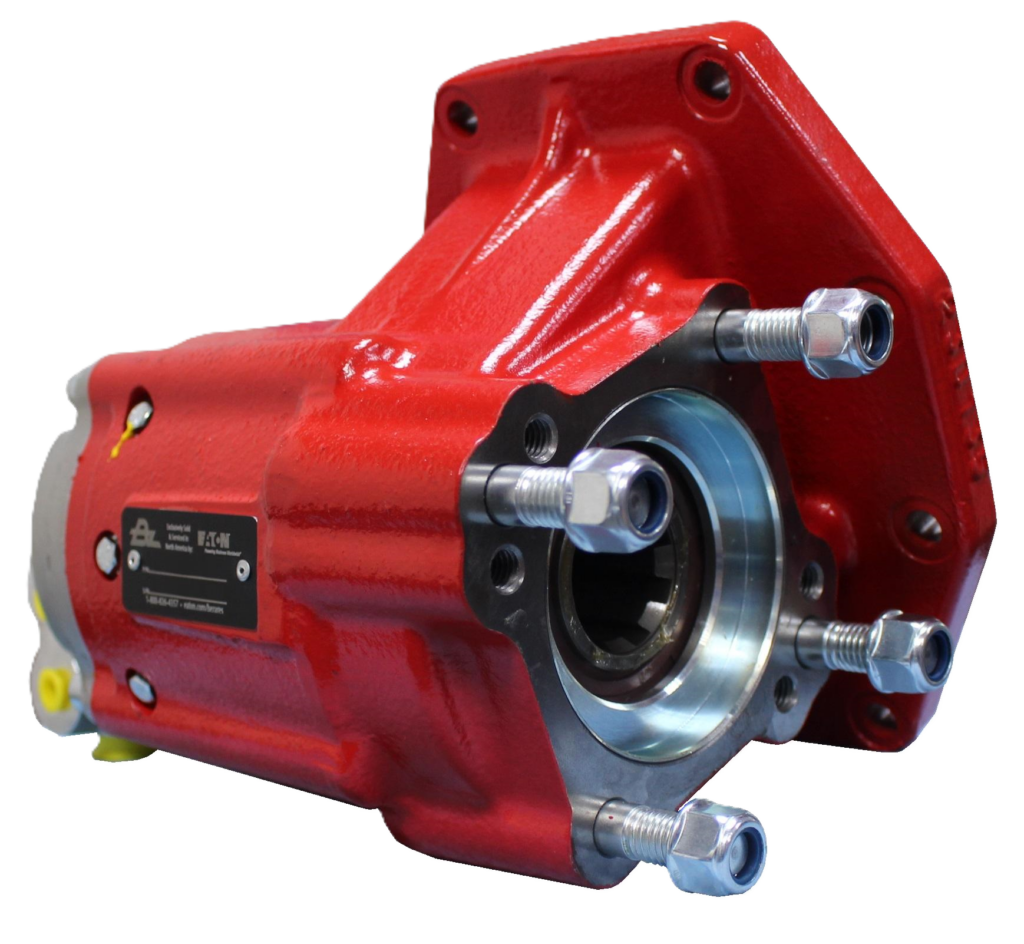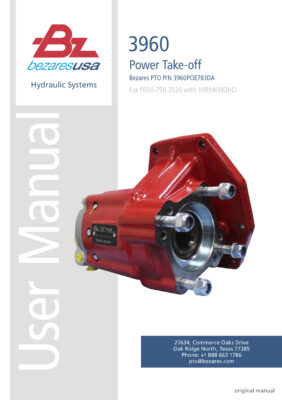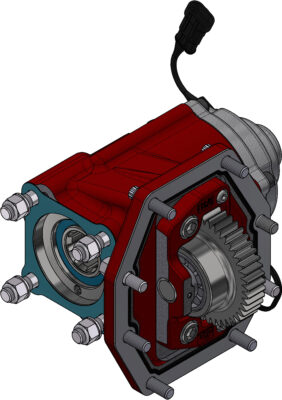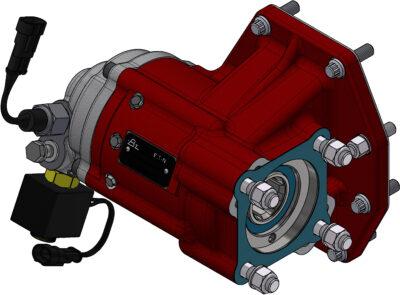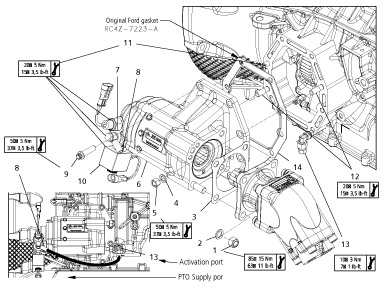Compatible with the most common transmissions in the market. The 3960 series PTOs feature a wide range of input gear, ratio, output, and shifter options. All cast iron construction with large 12mm flange bolts to support some of the larger pumps in the market.
Features and benefits:
- Unique hot shift unit that offers a DIN 5462 output shaft option as standard.
- Special design, allowing a variety of output adapter options.
- Deep gear tooth carburization for longer gear life.
- Larger flange mounting hardware provides additional support and reduces failures caused by heavy pumps – best in class.
- Industry leading Garlock gasket material provides better tear resistance and easier installation, with Viton o-ring material & shaft seals to prevent leaks.
- Clutch pack material is designed to provide smooth engagement and long life.
- Quiet operational noise levels for an improved operator experience.
Competitive with:
- Chelsea 210
- Muncie F20
Torque ratings: up to 230 lb. ft.
Typical Applications: Dump Trucks and Trailers, Walking Floor, Low Boy, Vacuum Pumps, and more…..
CAUTION
TO PREVENT POSSIBLE INJURY:
- DO NOT go underneath the vehicle with the engine running.
- DO NOT attempt to work on an installed Power Take-Off with the engine running.
- DO NOT operate the controls of the Power Take-Off or other driven equipment from underneath the vehicle with the engine running.
- DO NOT operate the controls of the Power Take-Off or other driven equipment in any position that could result in getting caught in the moving machinery.
Make sure to block any moving or raised device that may injure a person working on or under the truck. A lever or its linkage may be accidentally moved causing movement of the device which could cause injury to a person near the device.
IMPORTANT
Because most of our Bezares Power Take–Offs and P.T.O. drive lines are sold through distributors, the product applications and the resulting degree of exposure to danger of the operators are beyond the knowledge and controls of BEZARES.
Therefore, the proper installation of the P.T.O. and its associated equipment, and the decisions of whether to install guards and/or warning signs shall be the responsibility of the designers or installers.
Since it is our major objective to show you how to get additional and more profitable miles from truck, tractor and trailer components, we want to provide you with information on the installation of 3940 Series.
We all realize that an inadequate transmission will overwork any Power Take–Off in a very short period of time. In addition, a mismatched transmission/P.T.O. combination can result in unsatisfactory performance of the equipment right from the start.
Before you order new trucks be sure that you’re getting the right transmission/P.T.O. combination. It is of vital importance for efficient performance to have adequate power.
To help you select the proper type, size and design of P.T.O. it is advisable to discuss your specific requirements with a Bezares P.T.O. specialist. They know their products and Power Take–Offs. They can inform you about everything you need to know about power, at the right time, before you specify components.
Here are some of the questions that are relevant to the Proper Selections of a Transmission mounted Power Take–Offs.
- What is the make and model of your transmission?
- Which P.T.O. opening will be used?
- What accessory is to be driven?
- How much horsepower is required to drive the accessory?
- What is the required rotation of the P.T.O.?
- What is the required P.T.O. output shaft speed as a percent of engine speed?.
- What is the required method of shifting the P.T.O., mechanical or pneumatic?
Once all of the answer to these questions have been determined, a transmission mounted P.T.O. can be selected to meet the horsepower, speed and rotation that you require.
Check out our PTO Selection form at bezares.com/pto-selection-tool/
Having made the selection of a P.T.O., you are ready to start the installation.
step 1: With Park brake set, place truck in neutral and start engine. Listen to engine and transmission Any transmission, gear noise may be more noticeable after PTO is installed which is caused by Torsional vibrations.
STOP ENGINE-Never go under truck with engine running!
step 2: If chassis is 4X4 remove or disconnect driveshaft for clearance
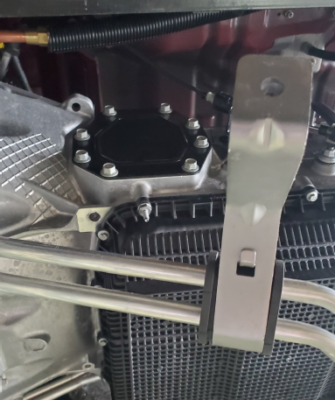
step 3: Locate the 8 bolt PTO aperture found on the driver’s side of the transmission.

step 4: Remove nuts holding the clamps on coolant lines running along driver’s side frame rail across transmission support bracket. This will make it easier to install the PTO and Pump. Lines can be reinstalled after installation is complete.

step 5: Remove and discard transmission PTO cover plate. Place a drain pan under the opening to catch a small amount of transmission fluid. Note: Remove and save Ford gasket!
It will be reused for PTO installation. Take care to prevent contaminants from entering PTO aperture.
Verify transmission PTO drive gear is present. Install guide pin (Coat threads with Loctite/Vibratite type thread locker).
Install step studs. Torque to 15-18 lb.Ft.
Attach the original Ford gasket. Mount PTO using flat washers and nuts. Tighten 2 o’clock and seven o’clock cap screws first to 37 lb.Ft. Torque the two nuts to 37 lb.Ft. Install and Torque remaining cap screws to 37 lb.Ft. Tightening in an “ “X” pattern.
CAUTION! If installing on a Gas Engine powered chassis: Prior to PTO installation, wrap exhaust down pipe with heat refective material. Exhaust header pipe wrap may be used or an aftermarket heat shield. It is also necessary to install reflective loom or heat protection sleeve on pressure switch wires as well as wiring to coil.
Caution
step 6: Locate the activation port on the transmission. (see drawing). It is located to the right of the PTO opening on the driver’s side of transmission. Install fitting in position as shown*. Attach activation hose to the fitting. Attach the banjo fitting end, with metaloplastic washers, to the rear cover. Install pressure switch tighten to 15-18 lb.Ft. If chassis has a gas engine, install heat resistant loom over pressure supply hose.
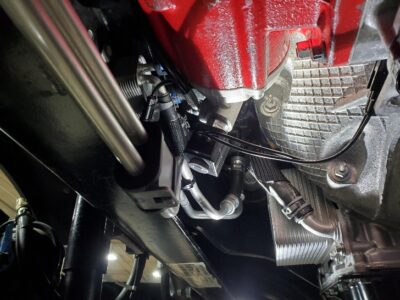
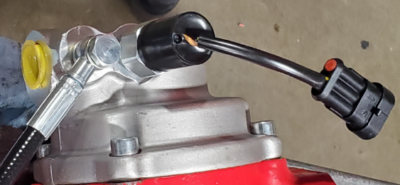
step 7: Install the valve stem and solenoid.
Add Loctite blue or Vibratite to solenoid nut.
Torque all to 15-18 lb.Ft.
Caution! Do not overtighten the aluminium nut or it can strip the threads.
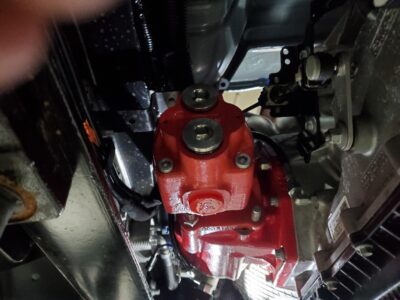
step 8: Attach pump gasket to studs. Mount pump with supplied flat washers and nuts. Torque to 63-70 lb.Ft.
step 9: Make sure that transmission fluid level is full.
Top off as needed.
1. Read and follow the truck’s manual before attempting to run PTO
2. Verify transmission has adequate fluid and extra fluid to compensate for PTO
(DO NOT OVER FILL)
3. Follow all company, federal, state and local safety procedures and guidelines.
4. Apply parking brake.
5. Truck must be in neutral.
6. Insert key in ignition.
7. Verify no one is under vehicle or near any rotating parts – ALL CLEAR!
8. Start engine, the PTO is not engaged, and the output shaft is not turning.
9. Depress the in-dash PTO #1 rocker switch, it will illuminate, the engine rpm
slightly increases.
10. The PTO now shifts, and the output shaft is rotating.
11. Depress the PTO rocker switch to disengage PTO and discontinue output shaft
rotation.
1. Check for leaks, fix any if found.
2. After truck warms up check all hardware for proper torque, tighten as needed.
3. Check all wire connections, ensure they are correctly installed and away from
heat and rotating parts, fix and repair as needed.
4. Check the airline, ensure it is correctly installed and away from heat and
rotating parts, fix and repair as needed.
The PTO is installed. Complete the rest of the associated equipment installation
CAUTION
This vehicle is equipped with a Power Take-off.
Shut engine off before working on Power Take-Off or getting below vehicle.
Consult operating instructions before using.
POWER TAKE-OFF OPERATION VEHICLE STATIONARY.
- Mechanical Transmission.
A power take-off is, and should be, operated as an integral part of the main transmission.
Before shifting the power take-off into or our of gear, disengage the clutch and wait for transmission or P.T.O. gears to stop rotating. - Automatic transmission with manual shift P.T.O. (Includes air shift).
On automatic transmissions, the gears in the transmission turn when the transmission is in neutral, therefore, gear clashing will ocurr if the power take-off is shifted into gear at this time.
With converter driven gear:
• Shift transmission lever into any of drive positions. (This will stop the transmission gear from turning).
• Shift power take-off into gear.
Shift transmission into neutral. (This will start transmission gears turning.)
• Shift P.T.O. into gear before starting engine.
This procedure should eliminate gear clash. - Automatic transmission with power shift P.T.O’s
Engage P.T.O. with engine at idle speed. Power shift P.T.O.´s: engine must be at idle when P.T.O. is engaged. See transmission manufacture´s instructions for special procedures.
IMPORTANT
Failures to follow proper shifting or operating sequences will result in premature P.T.O. failure with possible damage to other equipment.
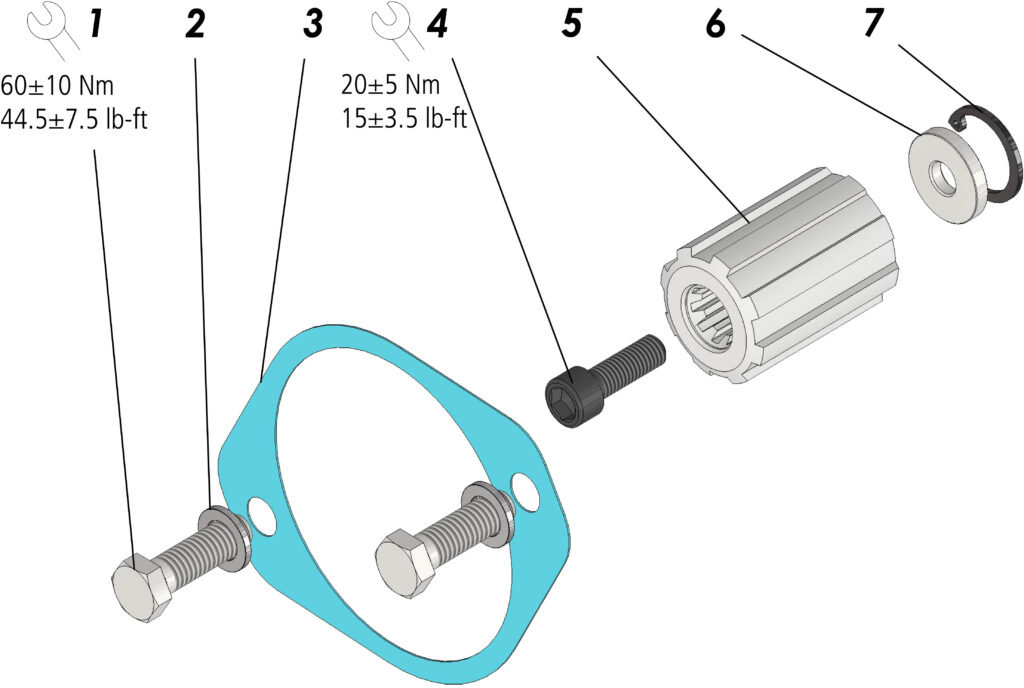
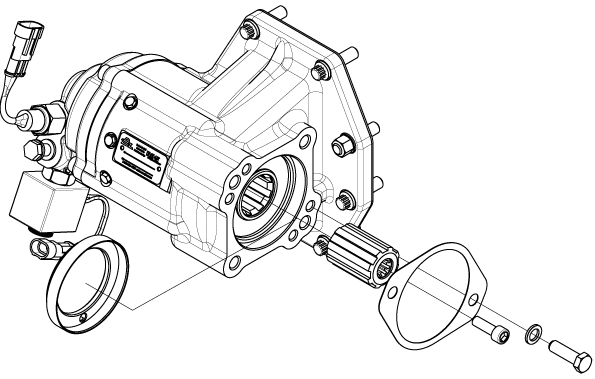
GENERAL INFORMATION
The following installation instruction for fitment of the conversion kit to PTO 3960 (part no.-806635, 806735, 806835) should be followed in order to ensure good performance and long life.
Where it is obvious that this instructions have not been followed, then warranty claims will not be accepted.
INSTALLATION METHOD
First, remove the adapter bush (*) from the PTO housing.
Next, be sure that the bush (6) and the elastic ring (7) are mounted on the adapter hub (5) before installing the hub in the PTO. And thread the Screw M8 (4) in accordance with the figure shown.
Finally, fit a gasket (3) between pump and PTO housing, fit the washers (2) on the screws (1) and tight them at the torque shown.
General Information
The following installation instruction for fitment of the PTO 3960 (10R140HD model year 2024 and later) should be followed in order to ensure good performance and long life.
Where it is obvious that this instructions have not been followed, then warranty claims will not be accepted.
Mounting Instruction List
Items – Description
1 – Nut(4x)
2 – Gasket
3 – Washer (2x)
4 – Nut (2x)
5 – PTO housing
6 – Pressure switch
7 – Fitting
8 – Screw (5x)
9 – Solenoid
10 – Guide (1x)
11 – Stud (2x)
12 – Fitting
13 – Original Ford Gasket
Installation Method
Install fitting (8) in PTO supply port. Position as shown in drawing. Next fit a pressure switch (7) and solenoid (10), in accordance with the torque shown.
Drain the gearbox and clean the cover plate and surrounding area to prevent ingress of dirt.
Remove and discard the PTO cover and save the Ford gasket, it will be reused for the PTO installation.
Install the studs (12) and guide (11) included in the mounting kit, in the correct location (see drawing).
Fit Ford gasket (14) over studs and guide, on the gearbox and mount the PTO housing (6).
Fit the PTO with the screws (9) and the nuts (5), with their washers (4) tighter in accordance with the torque shown.
Locate the activation port on transmission. It is located at the right of the PTO opening, install fitting (13) in position as shown in the drawing and fit activation hose to fitting (13).
Fit a gasket (3) between pump and PTO housing (6), apply pressure on nuts (1) and their washers (2) in accordance with the torque shown.
Do not forget to refill the gearbox with suitable oil and up to level.
Drive the vehicle for a short distance, park the vehicle and shut down, then verify.
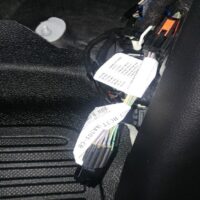
1- Locate the SEIC wiring harness connector located under the hood on the driver’s side.
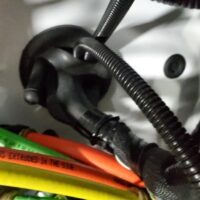
2- Locate the large grommet on the firewall. Pass through the SEIC wires from the inside and terminate with detached SEIC connector. Drop down the solenoid and pressure switch connector wires and plug them in. Feed the other side of those wires through the grommet. Inside the cab located on the drivers’ side are the grounding bolt and Auxiliary upfit switch # 1 yellow wire.
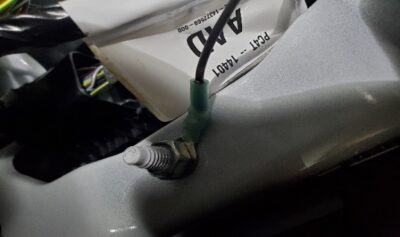
Grounding Bolt-Drivers Kick Panel
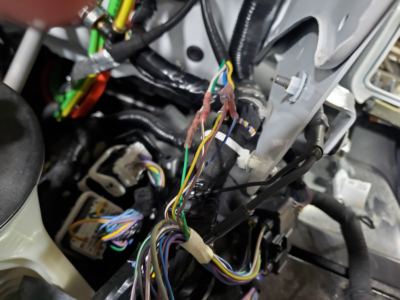
SEIC Connector-Joined with Harness
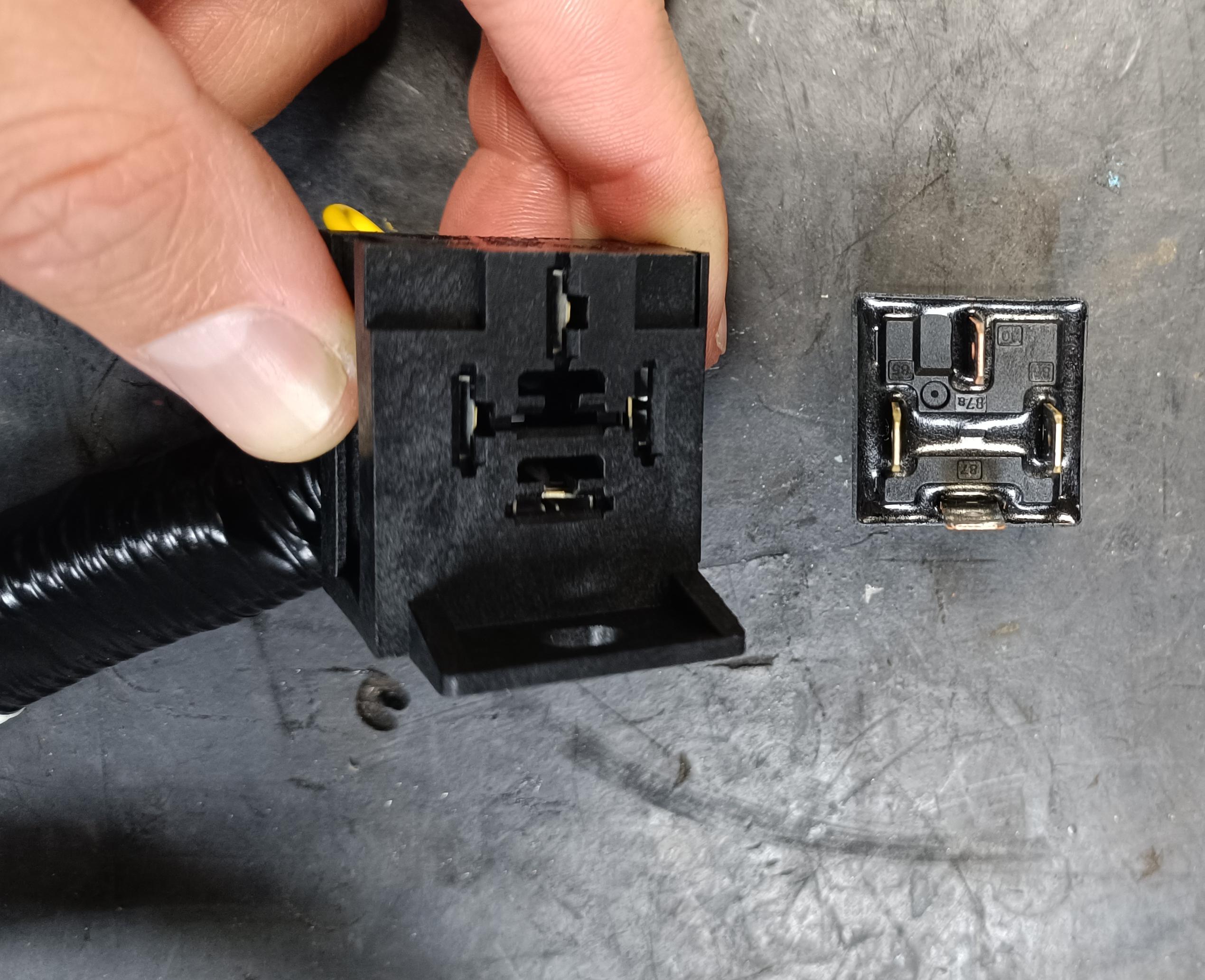
3- Attach the relay to an accessible location under the dashboard.
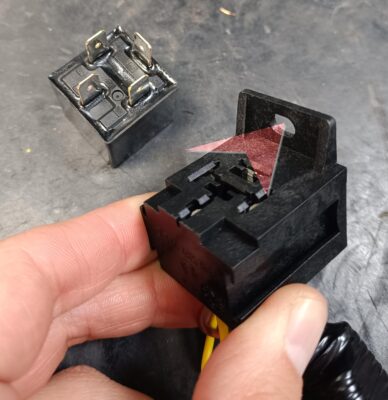
Remove the relay from the bracket and mount the relay bracket using a tie strap or a screw through the mounting bracket hole.
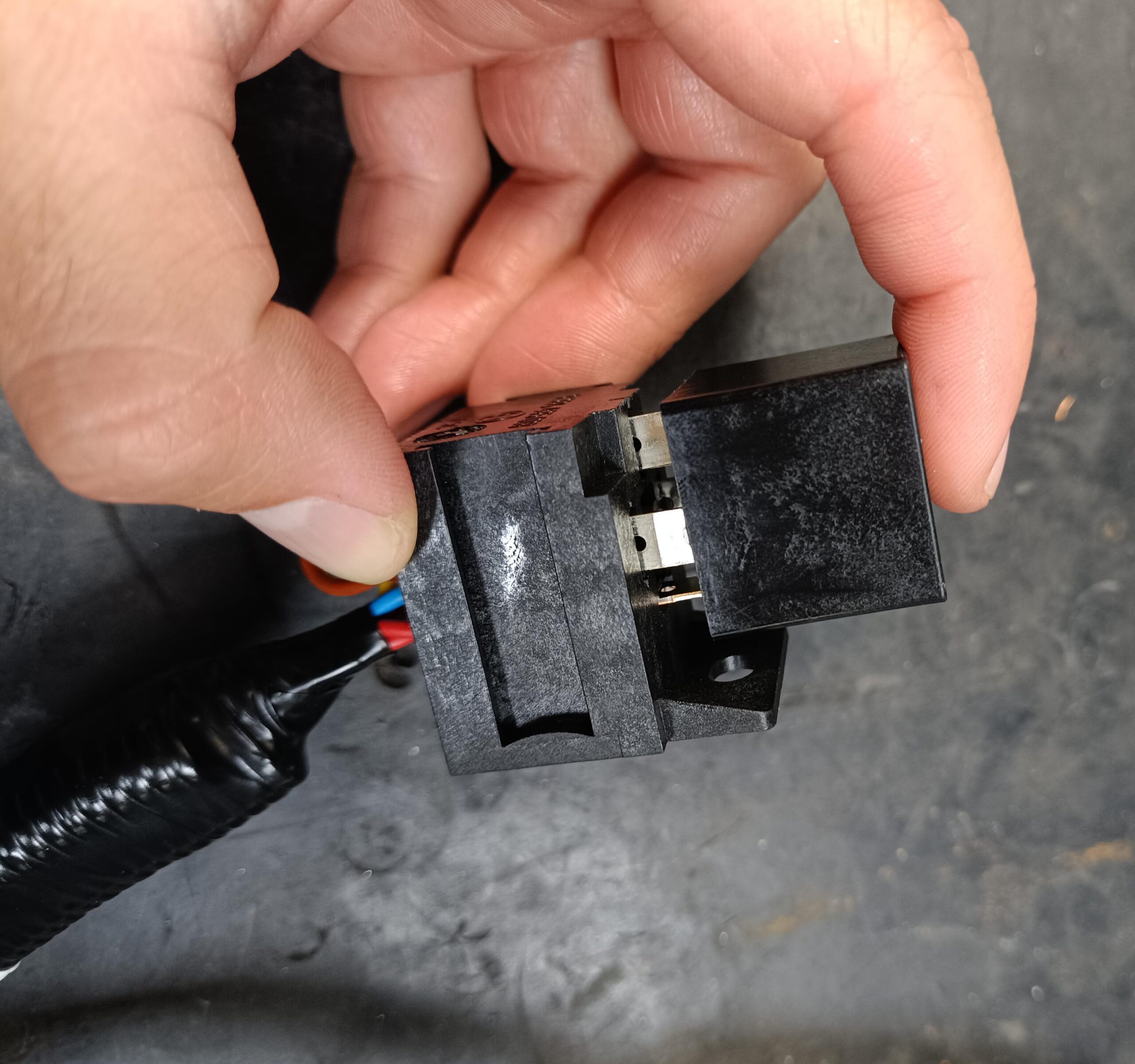
4- Reassemble the relay following the correct pin pattern.
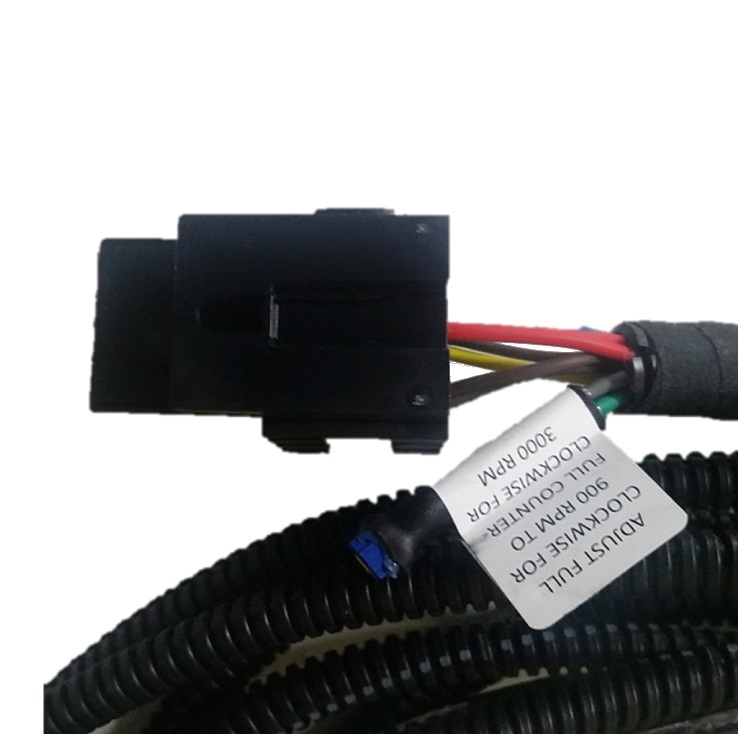
5- Start truck, engage PTO, verify engine RPM (should be 1200 RPM minimum). Adjust potentiometer (blue object in picture) as needed.
Note: This Harness have a main part, including relay and jumper part, to connect the pressure switch and the solenoid valve.
Bezares to Ford (diesel) colored wiring
| => | Green- CE914-(PTO RPM) | Pin 7 |
| => | White/Brown LE434-(DIESEL PTO VREF) | Pin 13 |
| => | Yellow/Violet- RE407-(PTO GAS SIGNAL RETURN) | Pin 3 |
| => | Blue/Red- CE326-(PTO RELAY) | Pin 11 |
| => | Yellow/Green- CE912-(PTO REQ 1)-Stationary Mode | Pin 4 |
| => | OR Blue/Orange- CE933-(PTO REQ 2)-Mobile Mode | Pin 5 | |
| => | 12V hot for customer installed indicator light. | |
| => | Pressure switch ground loop for customer supplied indicator light. | |
| => | Auxiliary switch # 1(yellow)- Tag marked (Upfit relay 1) | |
| => | BATTERY GROUND or Ground bolt located on driver’s side kick panel |
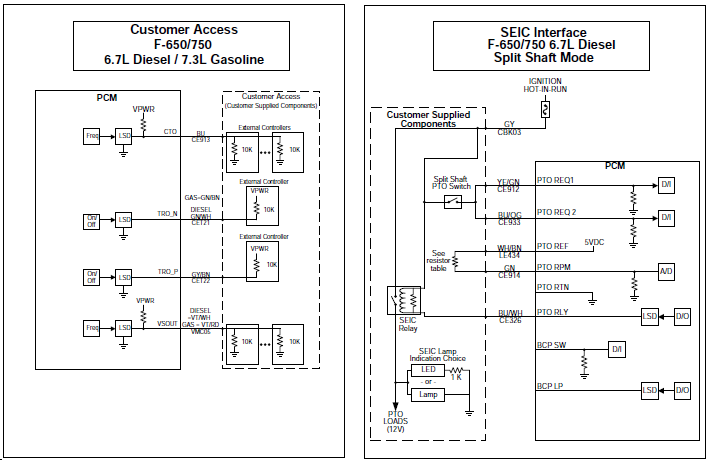
SEIC – PTO Enable / Disable conditions
| Vehicle Conditions to Enable SEIC (all are required) | Vehicle Conditions that Disable SEIC (any one required) | SEIC | Split-Shaft (Diesel Only) | Mobile Mode | BCP |
|---|---|---|---|---|---|
| Parking brake applied | Parking brake disengaged | Yes | Yes | No | Yes |
| Foot off service brake | Service brake depressed | Yes | Yes | No | Yes |
| Vehicle in Park | Vehicle taken out of Park | Yes | Yes | No | Yes |
| Foot off accelerator pedal | Accelerator pedal depressed | Yes | Yes | No | Yes |
| Vehicle speed is 0 MPH (stationary) | Vehicle speed is not 0 MPH | Yes | Yes | No | Yes |
| Engine at a stable base idle speed | — | Yes | Yes | No | Yes |
| Transmission oil temp above 20ºF | Transmission oil temperature exceeds 240ºF (Diesel) or 250ºF (Gas) | Yes | Yes | Yes | Yes |
| Engine coolant termperature at least 20ºF (6.7L Diesel) | Engine coolant temperature exceeds 230ºF | Yes | Yes | Yes | No |
| Engine coolant termperature at least 20ºF (6.2L or 7.3L Gas) | Engine coolant temperature exceeds 230ºF | Yes | N/A | Yes | Yes |
| — | Catalist temperature limit | Yes | Yes | Yes | Yes |
BEZARES to FORD SEIC Circuit Wiring- 2020/2021 10R140HD-6.2-7.3L-GAS- F250-600
| => | Green- CE914-(PTO RPM) | Pin 7 |
| => | White/Brown LE434-(DIESEL PTO VREF) | Pin 13 |
| => | Yellow/Violet- RE407-(PTO GAS SIGNAL RETURN) | Pin 3 |
| => | Blue/Red- CE326-(PTO RELAY) | Pin 11 |
| => | Yellow/Green- CE912-(PTO REQ 1)-Stationary Mode | Pin 4 |
| => | OR Blue/Orange- CE933-(PTO REQ 2)-Mobile Mode | Pin 5 | |
| => | 12V hot for customer installed indicator light. | |
| => | Pressure switch ground loop for customer supplied indicator light. | |
| => | Auxiliary switch # 1(yellow)- Tag marked (Upfit relay 1) | |
| => | BATTERY GROUND or Ground bolt located on driver’s side kick panel |
Note! When using the Auxiliary Upfitter Switch # 1, the pressure switch port may be plugged. This will eliminate a PTO indicator light. If a true PTO indicator light is desired the upfitter can install their own indicator light. This requires the Pressure Switch to be installed in PTO rear cover. Connect the Pressure Switch ground loop (purple) wire and the 12 V switched (red) wire to customer supplied PTO indicator light.
Proper maintenance of your Power Takeoff (PTO) is crucial to ensure the longevity and optimal performance of your vehicle. Follow these tips to maintain your PTO:
Safety First: Do not go under or near PTO when the engine is running. Shut off the engine and disconnect batteries on electric motor-driven PTOs (i.e., hybrid vehicles) before checking or servicing.
Service Intervals: The PTO, being an integral part of the transmission, should be serviced at the same intervals as the transmission. Transmission fluid changes should follow the interval recommended by the vehicle manufacturer for severe service.
Check for Leaks: Checking for PTO leaks and checking the transmission oil level should be done regularly. Loss of oil can significantly affect or damage the transmission. Check for leaks upon delivery of the vehicle and after initial operation of equipment.
Maintenance Checks: The PTO requires periodic checks. Typically, the interval for maintenance checks of the PTO depends on the application of the vehicle. For severe-duty PTO applications, it is recommended that the PTO be checked for service every 100 hours of use (this guideline can be adjust-ed based on past service history once you have it established). Service should include checking and lubricating direct-mount pump shaft connections on a regular basis.
Recheck the Installation: Within the first week of use, recheck the installation of the PTO. Check for leaks in air lines or hydraulic connections with air shift or hot shift PTO’s and loose mounting hardware (studs, cap screws, nuts). Recheck the cables or lever connections for proper adjustments and lubricate moving parts, tighten and repair ALL connections, hoses, mounting hardware, cable, and lever connections.
Visual Inspection: It is recommended that the operator/owner do a visual inspection for leaks under and around the vehicle and equipment before entering or starting the equipment on at least a weekly basis. Any leaks should be corrected immediately.
Anti-Seize or High-Temperature Grease: Pumps that are directly mounted to the PTO output require the application of anti-seize or a high-temperature, high-pressure grease (unless the PTO is a wet spline option). The purpose of this grease is to help make the PTO easier to service and to reduce the effects of fretting corrosion on the mating PTO and pump shafts. PTO’s under severe duty cycles and/or high torque requirements may require servicing of this pump shaft connection by periodically regreasing the shafts. Vehicles with low-speed engines are also considered severe duty applications due to the inherent vibrations of the vehicles. Fretting corrosion cannot be stopped by greasing the shafts; it is only a deterrent. Wet spline PTO’s do not require servicing this connection.
Remember, failure to comply entirely with the provisions set forth in the appropriate Owner’s Manual will result in voiding of ALL Warranty consideration.
For any queries, contact your equipment installer.
